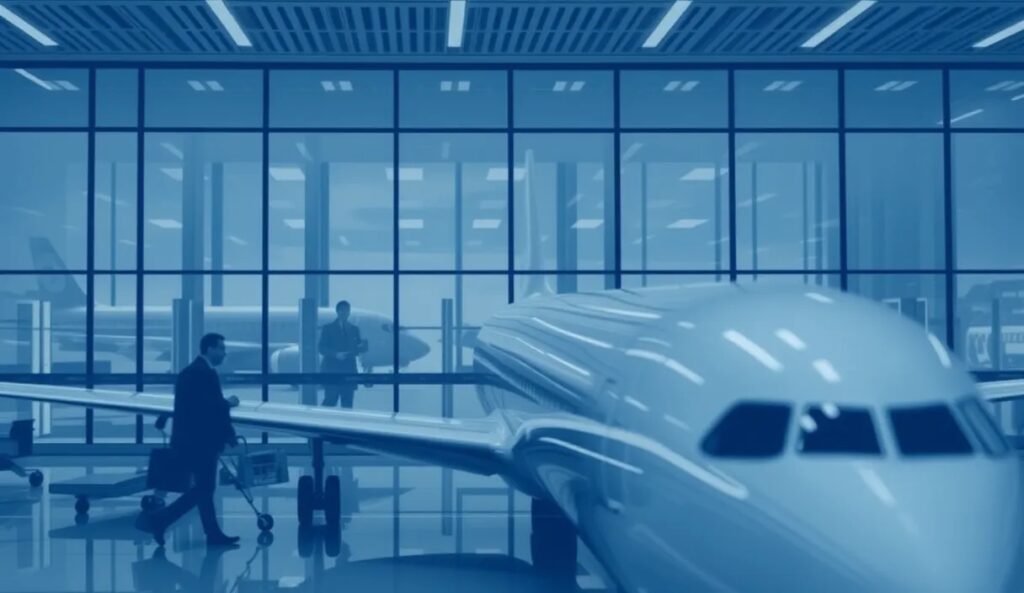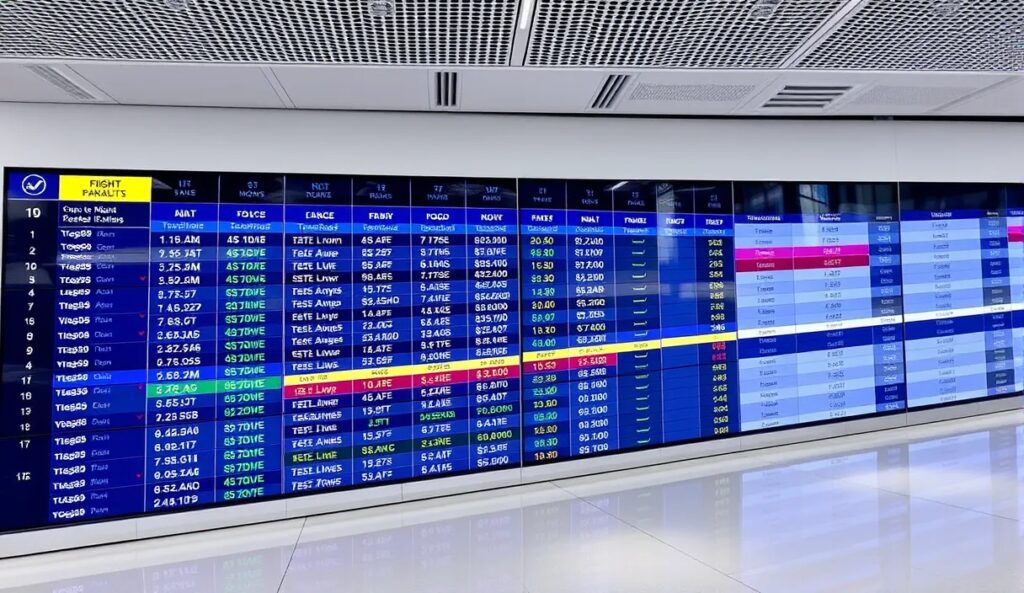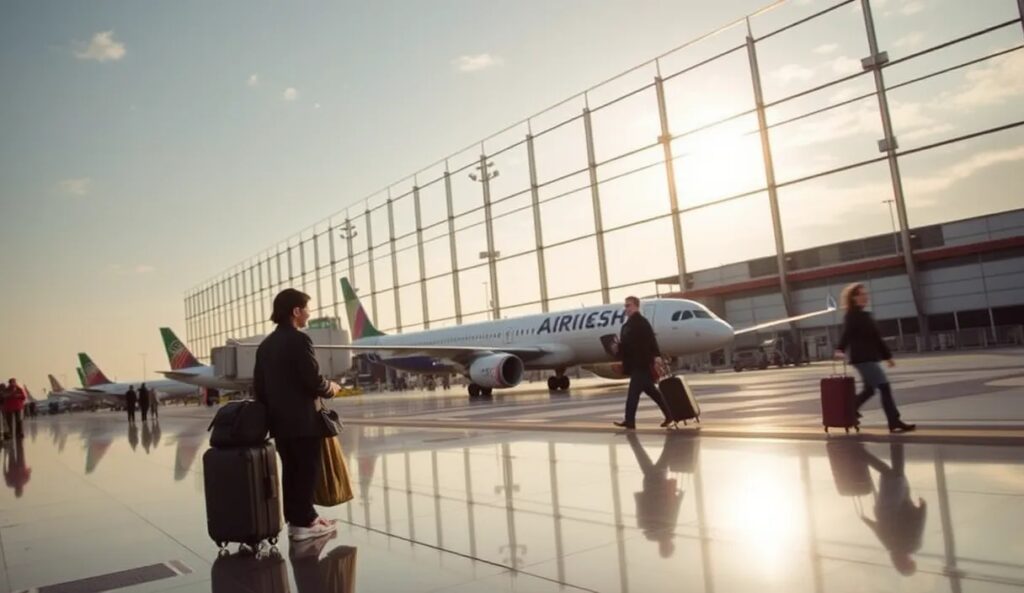
Flight scheduling is a complex puzzle. Coordinating long-haul flights that span continents and short-haul flights with quick turnarounds takes precision. Here’s where AI technology steps in.
By analyzing mountains of data, AI ensures smoother operations for both types of flights.
For long-haul schedules, AI can account for weather, air traffic congestion, and crew rest needs. Short-haul operations benefit from AI’s ability to optimize gate assignments and turnaround times in real-time.
These capabilities minimize delays and maximize efficiency. Airlines see lower costs, while passengers experience fewer disruptions.
Understanding Key Differences Between Long and Short Hauls
AI treats long-haul and short-haul flights differently because their challenges aren’t identical. For long-haul flights, managing fuel consumption and route planning are top priorities. AI models incorporate real-time weather data and adjust for turbulence to save fuel.
Short-haul flights, however, demand rapid decision-making. AI excels here by predicting airport congestion and aligning tight schedules. In both cases, AI enhances reliability, but the methods it employs vary significantly.

Long-Haul Scheduling: Navigating the Complexity
Fuel Efficiency as a Driving Factor
Fuel accounts for a major slice of airline expenses, especially on long-haul routes. AI tools like predictive analytics are revolutionizing this area.
By assessing wind patterns, flight paths, and altitude adjustments, AI reduces unnecessary fuel consumption. This doesn’t just save money—it significantly cuts carbon emissions, a growing priority for airlines worldwide.
Balancing Crew Schedules and Legal Compliance
Managing flight crews on long-haul trips is no easy feat. International labor regulations often require minimum rest periods, and AI ensures compliance without over-scheduling staff.
AI systems create optimal rosters, balancing work hours with legally mandated rest. This proactive planning avoids costly last-minute schedule changes and keeps airlines compliant.

Short-Haul Scheduling: The Need for Speed
Real-Time Solutions for Dynamic Environments
Short-haul flights often operate in fast-paced settings. Delays at one airport can ripple across a day’s schedule. AI algorithms analyze live data, offering instant solutions like rerouting planes or reassigning crews.
For instance, if a snowstorm disrupts Chicago flights, AI might proactively shift departure times in surrounding cities. This level of agility ensures passengers make connections without unnecessary headaches.
Maximizing Aircraft Utilization
AI also helps airlines get the most out of their fleets. With machine learning models, carriers can calculate how to rotate planes between short-haul routes efficiently. This minimizes idle time and extends aircraft service life, reducing overall operational costs.
Comparative Benefits of AI for Passengers
Enhanced On-Time Performance
Whether you’re flying across the globe or just hopping between cities, delays can ruin plans. AI systems drastically improve on-time performance by predicting and resolving issues before they escalate.
For passengers on long-haul flights, AI ensures smooth layovers by coordinating arrival and departure schedules across international hubs. On short-haul flights, AI prevents cascading delays by optimizing gate assignments and real-time rerouting.
This proactive approach translates to fewer missed connections and more dependable travel experiences, giving passengers peace of mind.
Tailored Passenger Experiences
AI doesn’t just help airlines; it improves the passenger journey too. By analyzing customer data, airlines can offer more personalized services.
For example, long-haul passengers may receive tailored inflight meal options based on past preferences. Short-haul passengers benefit from expedited check-ins and updates about gate changes via AI-powered apps. These small touches make flying less stressful, no matter the distance.
The Environmental Impact of AI in Flight Scheduling

Fuel Optimization Reduces Carbon Emissions
AI-driven fuel efficiency isn’t just good for airline budgets; it’s a win for the environment too. Long-haul flights, which burn massive amounts of fuel, are becoming greener through AI’s optimized route planning.
For short-haul routes, the gains are subtler but significant. AI ensures aircraft operate at peak efficiency by avoiding unnecessary idling and delays, cutting down on overall fuel use. These advancements help airlines meet stricter environmental regulations and appeal to eco-conscious travelers.
Supporting Sustainable Aviation Goals
The aviation industry is under pressure to achieve net-zero emissions by mid-century. AI contributes by enabling better fleet management and smarter scheduling. For instance, AI identifies opportunities to substitute smaller, more efficient planes for low-demand short-haul routes.
On long-haul journeys, AI can even recommend lighter aircraft configurations to reduce fuel burn without compromising safety. These data-driven solutions are essential to achieving sustainability goals.
Bridging Long-Haul and Short-Haul Challenges with AI
Creating a Seamless Global Network
The true power of AI lies in its ability to integrate long-haul and short-haul scheduling into a seamless network. Airlines operating international hubs depend on this integration to maintain efficient operations.
For example, AI can adjust schedules for incoming long-haul flights to ensure short-haul connections run smoothly. Passengers experience seamless transitions from one leg of their journey to the next, reducing missed flights and improving satisfaction.
Scaling Benefits Across the Industry
AI’s adaptability makes it a valuable tool for airlines of all sizes. Large carriers use it to manage intricate global networks, while smaller regional operators rely on it to maximize fleet utilization. This scalability ensures AI’s benefits are felt industry-wide, making air travel more reliable and sustainable for everyone.
Conclusion: AI as a Game-Changer in Flight Scheduling
AI has revolutionized flight scheduling for both long-haul and short-haul operations, addressing distinct challenges with precision and innovation. From optimizing fuel efficiency on intercontinental journeys to mitigating cascading delays on regional routes, AI transforms airline operations at every level.
Passengers benefit from smoother connections, personalized experiences, and improved reliability. Meanwhile, airlines achieve cost savings, regulatory compliance, and environmental sustainability—a win-win for all stakeholders.
As the aviation industry continues to embrace AI, the gap between long-haul and short-haul complexities narrows. This technology not only improves operational efficiency but also lays the groundwork for a more connected, sustainable, and passenger-friendly future in air travel.
FAQs

Can AI help reduce environmental impacts in aviation?
Yes, AI plays a crucial role in minimizing aviation’s environmental footprint. On long-haul routes, AI analyzes wind patterns to chart fuel-efficient flight paths, cutting down emissions.
For short-haul flights, AI reduces unnecessary idling at airports and improves aircraft rotations, ensuring planes spend less time on the ground burning fuel. Airlines like Delta and Lufthansa already use AI to support their sustainability efforts.
What are some examples of AI-driven personalization for passengers?
AI tailors travel experiences by analyzing customer data. For instance, frequent long-haul travelers might receive tailored inflight entertainment recommendations or meal options that suit their preferences.
On short-haul routes, AI enables dynamic seat upgrades or personalized notifications about gate changes. An app might alert a passenger about shorter security lines or offer last-minute deals on lounge access, all thanks to AI.
How does AI manage the complexities of crew scheduling?
AI creates optimized rosters by balancing crew work hours with legal rest requirements, especially on long-haul routes. For example, an AI system might schedule a crew member to operate a 12-hour transatlantic flight, ensuring compliance with rest mandates by scheduling them for a layover break before their return flight.
For short-haul flights, where shifts can be tighter, AI predicts potential delays and adjusts rosters on the fly, avoiding costly disruptions like last-minute replacements.
Is AI equally beneficial for small and large airlines?
Absolutely. Large carriers use AI to streamline complex international schedules, while regional airlines utilize AI to maximize aircraft utilization.
For example, a major airline might use AI to coordinate long-haul arrivals at a hub with multiple short-haul departures. A smaller carrier, operating within a single region, could deploy AI to manage tight turnaround times and reduce maintenance delays. Both scenarios highlight AI’s scalability and adaptability.
How does AI help airlines manage weather disruptions?
Weather disruptions are a major challenge for both long-haul and short-haul flights, and AI mitigates these issues effectively. For instance, if a storm is expected to affect transatlantic routes, AI can recommend alternative flight paths, saving time and fuel while maintaining passenger safety.
On short-haul routes, where schedules are tighter, AI predicts airport weather conditions and adjusts departure times to avoid cascading delays. Airlines like American Airlines use AI to reroute flights in real-time, minimizing weather-related downtime.
Can AI predict passenger demand and adjust schedules accordingly?
Yes, AI excels at forecasting passenger demand by analyzing historical trends, booking patterns, and external factors like holidays or events. For example, AI might identify higher demand for long-haul flights to Europe during the summer and recommend additional flights or larger aircraft.
On short-haul routes, AI identifies underbooked flights and suggests consolidating passengers onto fewer aircraft, saving costs while maintaining service. This adaptability benefits both airlines and travelers.
How does AI optimize airport operations for short-haul flights?
AI plays a key role in streamlining airport logistics. For example, AI can assign gates dynamically to ensure smooth aircraft turnarounds. If a flight arrives early, AI can rearrange gate schedules to prevent delays for departing planes.
Additionally, AI tracks baggage handling, ensuring that short-haul flights with tight turnarounds don’t face delays due to misplaced luggage. This efficiency is particularly valuable in busy hubs like Atlanta or Heathrow.
Does AI help airlines manage maintenance schedules?
AI significantly enhances aircraft maintenance, ensuring safety and minimizing disruptions. For long-haul flights, AI predicts maintenance needs based on real-time performance data, reducing the risk of in-flight issues on extended journeys.
For short-haul fleets, where planes operate multiple daily trips, AI schedules maintenance during off-peak hours to avoid grounding aircraft unnecessarily. Southwest Airlines, for example, uses predictive maintenance AI to keep its planes flying reliably.
Are there risks or challenges in using AI for flight scheduling?
While AI offers tremendous benefits, challenges do exist. One concern is data quality; AI relies on accurate, up-to-date information. If data inputs are flawed, recommendations may be less effective.
Additionally, integrating AI into legacy systems can be costly for airlines, particularly smaller carriers. However, these challenges are often outweighed by the long-term operational and cost efficiencies AI delivers.
How does AI contribute to smoother international connections?
For long-haul passengers connecting to short-haul flights, AI ensures seamless transitions by synchronizing schedules. If a transcontinental flight is delayed, AI can notify the connecting airport to adjust short-haul departures, preventing missed connections.
For example, Emirates uses AI to coordinate hub operations in Dubai, ensuring long-haul arrivals smoothly feed into a vast network of short-haul regional routes across the Middle East and beyond.
How does AI handle disruptions like strikes or technical failures?
AI can rapidly adapt to large-scale disruptions such as crew strikes or technical failures. During a pilot strike, for example, AI helps airlines prioritize high-demand routes, reallocating resources like crew and planes to minimize passenger impact.
Similarly, if a technical failure grounds an aircraft, AI reroutes passengers and reallocates available planes, reducing delays and cancellations. Airlines like Ryanair have used AI to navigate operational disruptions effectively, preserving schedules.
Can AI reduce costs for budget airlines?
Budget airlines thrive on efficiency, and AI helps them achieve this by optimizing routes, schedules, and fleet utilization. For instance, AI can analyze fuel prices and recommend the best times for refueling, saving costs over time.
It also helps plan short-haul flights with tighter turnarounds, ensuring planes spend minimal time idle. This is critical for low-cost carriers like EasyJet, which operate on narrow profit margins.
Does AI help with passenger safety during flights?
Absolutely. AI contributes to passenger safety by enhancing real-time decision-making. On long-haul flights, AI systems monitor weather, turbulence, and aircraft performance, suggesting adjustments to the route or altitude to ensure a smoother journey.
For short-haul flights, AI supports quick decisions in emergency situations, such as rerouting to alternate airports due to sudden changes in weather or mechanical issues. These advancements give pilots critical support when they need it most.
How is AI shaping the future of aviation sustainability?
AI is integral to the future of sustainable aviation. By optimizing fuel usage, reducing unnecessary flights, and even supporting the development of electric aircraft, AI is paving the way for greener skies.
For example, AI can analyze passenger demand trends to recommend more efficient long-haul routes or suggest replacing short-haul flights with rail alternatives in regions where it’s feasible. Airlines like Air France-KLM are already exploring such AI-driven sustainability measures to reduce their environmental impact.
How are airlines integrating AI with other technologies?
Airlines are combining AI with technologies like IoT (Internet of Things) and blockchain to revolutionize flight scheduling. IoT sensors provide real-time data on aircraft health, which AI uses to predict maintenance needs. For example, Lufthansa integrates IoT-enabled systems with AI to reduce unexpected downtime for its long-haul fleet.
Blockchain, when paired with AI, ensures secure data sharing among airlines and airports. This improves schedule coordination, particularly for long-haul flights with multiple connecting partners. Singapore Airlines has tested blockchain-powered ticketing systems integrated with AI to enhance efficiency.
How does AI improve passenger experiences beyond scheduling?
AI enhances the end-to-end travel experience in ways beyond flight timing. Chatbots powered by AI provide 24/7 customer support, handling everything from flight inquiries to real-time updates on delays or cancellations. Delta Airlines uses AI to send personalized messages with rebooking options during disruptions.
For in-flight experiences, AI systems tailor recommendations for entertainment, meals, and even ideal seat selections. On long-haul flights, airlines like Emirates offer AI-curated playlists and meal preferences based on prior journeys.
Are there examples of AI-driven sustainability initiatives in aviation?
Yes, several airlines are leveraging AI to support sustainability. Air France-KLM uses AI to optimize flight paths, reducing emissions by identifying the most fuel-efficient routes.
On short-haul routes, Ryanair uses AI to recommend optimal speeds and altitudes, further reducing fuel burn. These AI strategies align with the aviation industry’s broader goals to meet carbon neutrality targets by 2050.
Additionally, AI supports the shift to alternative fuels. By analyzing the availability of sustainable aviation fuels (SAFs), AI helps airlines plan routes that allow refueling at SAF-compatible airports, advancing the adoption of greener fuels.
How is AI transforming crew management on global scales?
AI has made global crew management much more efficient. For long-haul flights, airlines use AI to navigate complex international labor laws and varying time zones. British Airways, for example, uses AI to generate optimal crew schedules, ensuring compliance with international rest mandates while minimizing disruptions.
Short-haul crew management benefits from AI’s real-time problem-solving capabilities. If a crew member is delayed or unavailable, AI suggests quick replacements or adjusts rosters to prevent cascading delays.
What does the future hold for AI in aviation?
The future of AI in aviation looks incredibly promising. Emerging trends include the use of AI for fully autonomous route planning and predictive traffic management, which will be critical as passenger numbers grow.
Airlines are also exploring AI-driven hybrid aircraft technology for short-haul routes. This involves integrating electric engines with AI systems that optimize battery usage and performance. Companies like Boeing and Airbus are actively testing prototypes that rely heavily on AI for navigation and resource management.
Resources
Articles and Reports
- “How Artificial Intelligence Is Transforming Air Travel”
Forbes explores how AI reshapes operations from passenger experience to scheduling.
Read it here - “AI in Aviation: Fuel Efficiency and Flight Safety”
IATA details how airlines use AI to enhance operational efficiency and reduce carbon emissions.
Learn more here - “The Future of Flight Scheduling with AI”
A report from McKinsey examining AI’s potential to revolutionize flight operations worldwide.
View the report
Airline Case Studies
- Delta Airlines: AI and Real-Time Flight Adjustments
Delta uses AI-driven tools to manage disruptions and improve on-time performance.
Explore their innovation page - Lufthansa: Predictive Maintenance with AI
Lufthansa employs AI-powered analytics for fleet maintenance, saving millions annually.
Read their story - Singapore Airlines: AI and Passenger Personalization
Singapore Airlines leverages AI to personalize inflight experiences and optimize schedules.
Learn more





